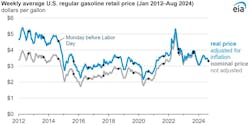US gasoline prices heading into Labor Day weekend lower than last year
Approaching the Labor Day weekend, retail prices for all formulations of regular gasoline in the US averaged $3.31/gal on Aug. 26, 2024, 13% lower than a year ago, according to the US Energy Information Administration (EIA). The decline in prices at the pump is due to weak global and US demand for petroleum products, continued growth in crude oil production outside of OPEC+, and a slowdown in China, EIA said.
On Jun. 2, 2024, OPEC+ members said most of their crude oil production cuts would be extended into 2025 in an effort to balance global oil supply and demand. Although crude oil and gasoline prices generally rose in the 4 weeks following the announcement, they have since retreated to pre-announcement levels.
The cost of crude oil is a major driver of the price of gasoline; EIA estimates the crude oil price contributed 55% to the price of gasoline as of June 2024. The Brent crude oil price decreased 4% from the same time last year and was $81/bbl on Aug. 26, 2024. Costs for refining crude oil, distribution and marketing of gasoline, and taxes make up the other components of retail gasoline prices.
“Because crude oil, gasoline, and other petroleum products are globally traded commodities, their prices are influenced by economic activity in major producing and consuming nations. Crude oil demand growth in China, the world’s top crude oil importer, has been slower in 2024 compared with previous years due to an economic slowdown, putting downward pressure on prices,” EIA said.
“Although the US has experienced less demand for gasoline for most of this year compared with 2023, we estimate that US demand heading into Labor Day weekend is greater than last year. Nonetheless, more gasoline is currently in US inventories than this time last year, at 221 million bbl, an increase of 3%.”
US gasoline prices vary regionally, reflecting local supply and demand conditions, different fuel specifications required by state laws, and taxes. Regional gasoline prices are usually the highest on the West Coast because of the region’s limited interconnections with other major refining centers (including the Gulf Coast), tight local supply and demand conditions, and requirements for gasoline specifications that are more costly to manufacture. West Coast prices as of August 26 averaged $4.05/gal, a decrease of $0.83/gal (17%) compared with the same time last year, the greatest decrease among the different regions.
Moreover, different weather conditions and unplanned refinery outages can cause different price movements across the regions. In July, Midwest prices increased slightly due to storm-related refinery outages. Gulf Coast oil production and refining was threatened by Hurricane Debby, which made landfall in Florida on Aug. 5, before easing and moving up the East Coast, but the storm did not significantly affect refinery activity or petroleum demand, according to EIA.
